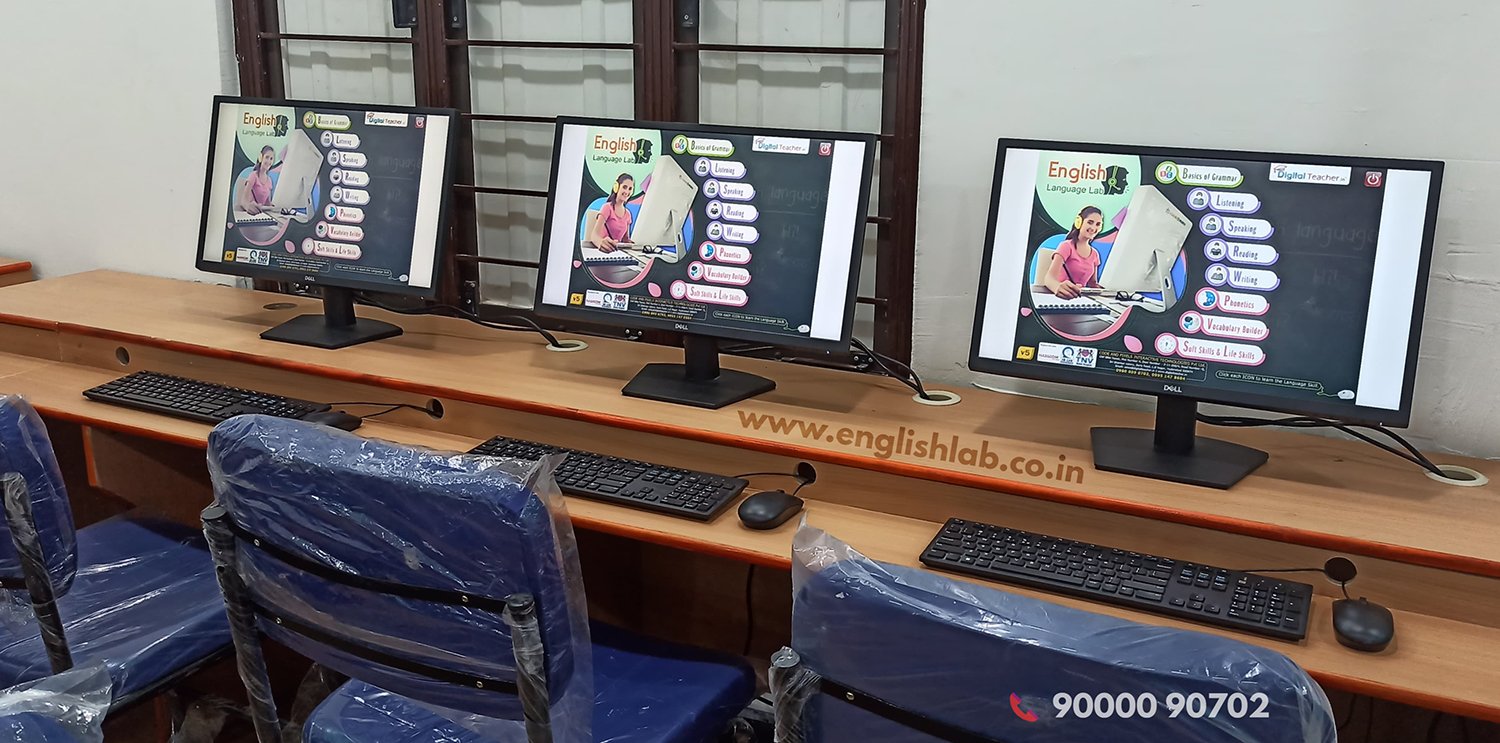How an ESL Lab Software Improves LSRW & Communication Skills

- In many Indian classrooms, English is still taught as a theoretical subject rather than as a skill to be used in daily life. As a result, students often do well in written exams but struggle to express themselves in spoken English. A major reason for this gap is the influence of regional languages (MTI), lack of consistent practice, and limited exposure to fluent English environments.
- We’ve designed our ESL Lab software to directly address these challenges. Our solution focuses on building complete LSRW (Listening, Speaking, Reading, Writing) skills and equipping learners with the confidence and clarity required to communicate effectively, both in academic and real-life settings.
What Is ESL Lab Software?
- The ESL Lab (English as a Second Language Lab) is a technology-powered language learning lab that transforms the way English is taught and learned. It complements classroom instruction by providing interactive, activity-based modules that develop fluency in a structured and engaging way.
- Unlike traditional English classes that rely heavily on textbooks and grammar drills, our ESL lab software immerses learners in real-life communication scenarios. It is widely used in schools, professional institutions, and ELCS labs for colleges to build language proficiency and workplace readiness.
What Does ESL Lab Software Primarily Focus On?
1. LSRW Skill Development
Our ESL Lab software follows a balanced approach to language acquisition, where all four foundational skills are given equal attention:
- Listening: Audio lessons, dialogues, and pronunciation drills to improve comprehension.
- Speaking: Voice recording, pronunciation practice, and peer interactions to build fluency.
- Reading: Vocabulary-based reading tasks that improve contextual understanding.
- Writing: Exercises that cover everything from sentence formation to professional writing.
This integrated approach ensures that students not only learn about English but also learn to use it.
2. Real-Time Communication Practice
Practice is the key to mastery. The ESL Lab is built with activity-based modules that promote:
- Voice modulation and pronunciation practice
- Speaking tasks with instant feedback
- Simulated real-world conversations
- Role-plays, group discussions, and presentations
By focusing on these real-time exercises, students become more confident speakers who can think in English and communicate without hesitation.
3. Addressing MTI (Mother Tongue Influence)
One of the most important and unique aspects of our ESL Lab is its role in reducing MTI, a common issue among Indian learners. MTI refers to the way a student’s native language affects their English speech, leading to incorrect pronunciation, grammatical errors, and unclear communication

How Our ESL Lab Tackles MTI:
- Phonetic Training: Helps students distinguish sounds that do not exist in their regional language.
- Accent Neutralization: Clear audio models allow students to mimic neutral English pronunciation.
- Record & Compare Tools: Learners can record their voice, compare with model speech, and make corrections.
- Safe Practice Environment: ESL Lab provides a judgment-free space to repeat and refine speech patterns until they become natural.
Whether it's a Tamil speaker saying "waater" instead of "water," or a Hindi speaker struggling with articles like "a" or "the," our software helps students identify and correct these issues over time.
Application in ESL Lab for Schools & Colleges
Our ESL Lab is suitable for a wide range of educational institutions, including:
- CBSE & State Board schools looking to strengthen students’ communication foundations.
- Engineering and degree colleges, especially where ELCS (English Language Communication Skills) labs are mandated.
- Professional institutions aim to prepare students for placement interviews and global work environments.
For colleges, our ESL Lab modules align with ELCS syllabi, focusing on:
- Presentation skills
- Interview readiness
- Group discussion techniques
- Workplace communication
In schools, it supports early-stage English acquisition and helps learners develop fluency from a young age, while gradually reducing the impact of MTI.
Why Institutions Prefer English Language Lab's ESL Solution
Whether you’re running a CBSE-affiliated school, a State Board institution, or a professional college, an English learning software like ESL Lab offers:

- Curriculum-aligned + Skill-based learning
- MTI-targeted pronunciation correction
- User-friendly software for teachers and students
- Builds communication, confidence, and soft skills
- Flexible implementation for offline Software
- The goal of English education should go beyond grammar and vocabulary—it should empower learners to express ideas, engage in conversations, and build confidence in real situations. Our ESL Lab software is built to do exactly that.
- By targeting LSRW skills and MTI, it bridges the gap between classroom learning and practical communication. For any institution committed to language excellence, investing in a digital language learning lab is not just an upgrade—it's a necessity.
Frequently Asked Questions:
1. What does ESL Lab software mean?
ESL Lab software is a technology-based platform that helps learners improve English as a second language by focusing on listening, speaking, reading, and writing skills through interactive activities.
2. How is ESL Lab different from traditional English classes?
Unlike textbook-based learning, ESL Lab provides practical, activity-driven lessons, pronunciation practice, and real-life conversation simulations to build fluency and confidence.
3. Who can benefit from using ESL Lab software?
Students in schools, engineering colleges, degree colleges, and professional training institutions can benefit from ESL Lab software, as well as individuals preparing for interviews or global communication.
4. Can ESL Lab be used offline in schools and colleges?
Yes. The software supports offline implementation, making it accessible for institutions without continuous internet connectivity.
5. Does the ESL Lab cover all LSRW skills equally?
Yes. It follows a balanced approach, ensuring equal focus on listening, speaking, reading, and writing so that learners develop complete communication skills.


